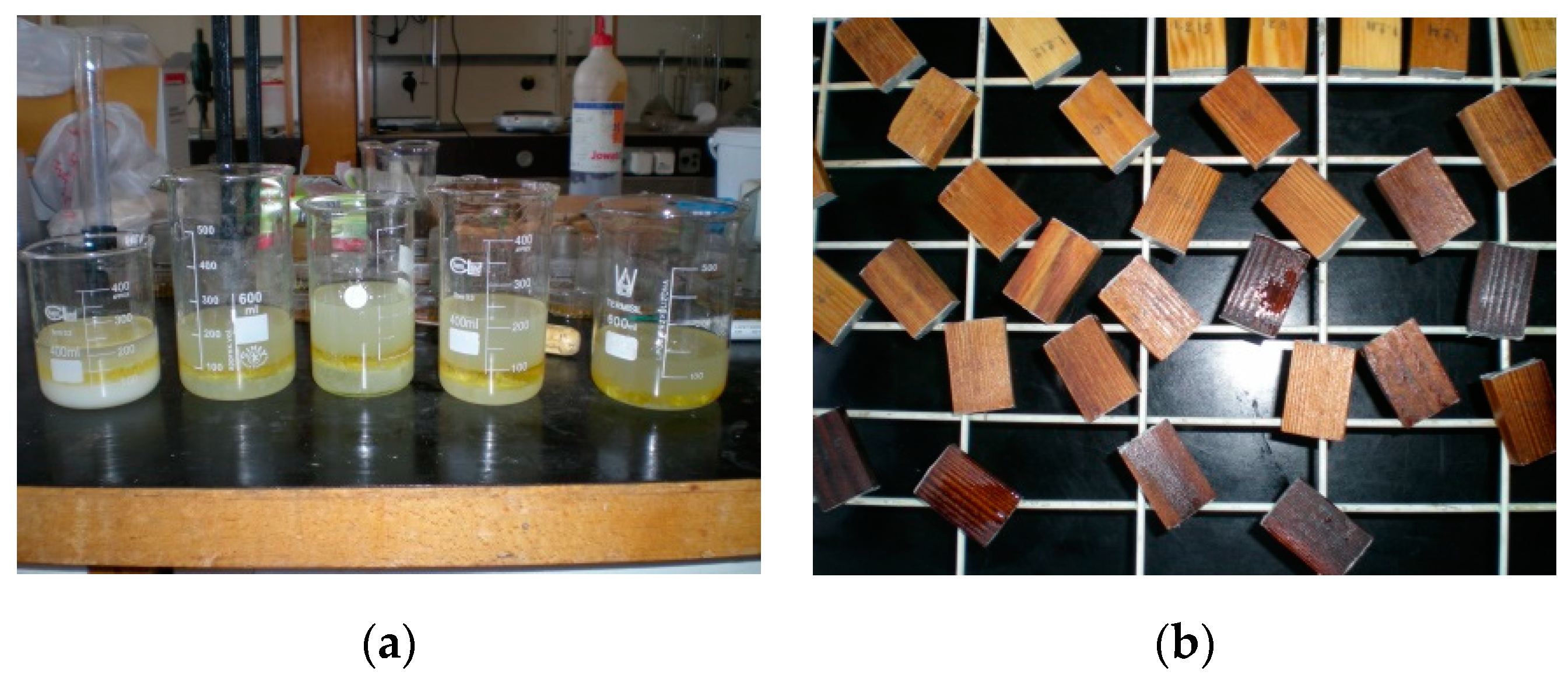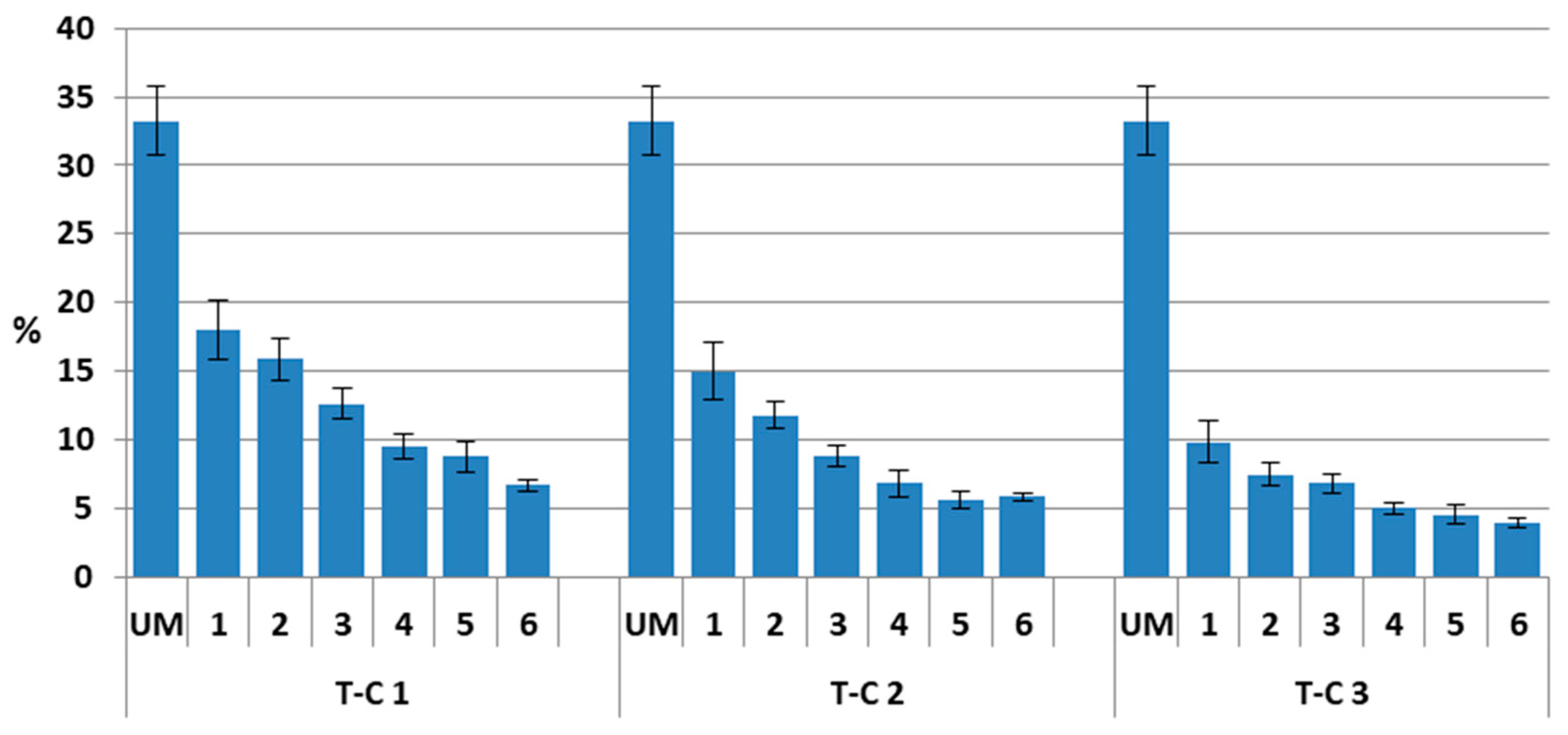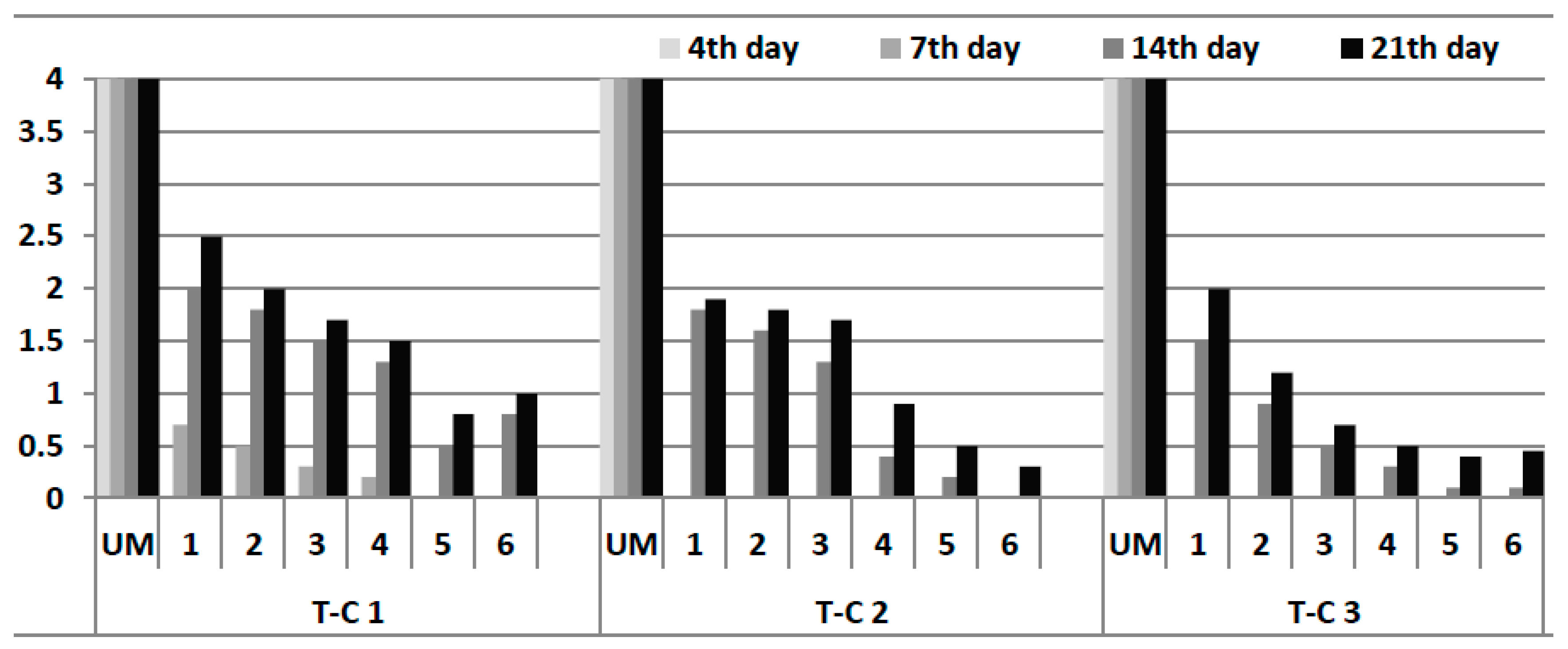The Biological Durability of Thermally- and Chemically-Modified Black Pine and Poplar Wood Against Basidiomycetes and Mold Action
Abstract
1. Introduction
2. Materials and Methods
2.1. Thermal Treatments
- ML: Mass loss (%)
- M0: Initial oven-dry mass of the specimen before thermal treatment (g)
- M1: Oven-dry mass of the same specimen after thermal treatment (g)
2.2. Chemical Treatment
2.3. Mycological Tests
2.3.1. Basidiomycetes
2.3.2. Microfungi
2.4. Statistical Analysis
3. Results and Discussion
3.1. Basidiomycetes
3.1.1. Thermal Treated Black Pine
3.1.2. Thermally-Chemically-Treated Black Pine
3.1.3. Thermally-Treated Poplar
3.2. Microfungi
3.2.1. Thermally-Treated Black Pine and Poplar
3.2.2. Thermally-Chemically-Treated Black Pine
4. Conclusions
Funding
Acknowledgments
Conflicts of Interest
References
- Hill, C. Wood Modification, Chemical, Thermal and other Processes; John Wiley & Sons Ltd: Hoboken, NJ, USA, 2006. [Google Scholar]
- Boonstra, M.J.; Acker, J.V.; Kegel, E.; Stevens, M. Optimization of a two-stage heat treatment process: Durability aspects. Wood Sci. Technol. 2007, 41, 31–57. [Google Scholar] [CrossRef]
- Militz, H. Thermal Treatment of Wood: European Processes and Their Background; IRG/WP 02-40241; The International Research Group on Wood Preservation: Stockholm, Sweden, 2002. [Google Scholar]
- Brischke, C.; Welzbacher, C.R.; Brandt, K.; Rapp, A.O. Quality control of thermally modified timber: Interrelationship between heat treatment intensities and CIE L*a*b* color data on homogenized wood samples. Holzforschung 2007, 61, 19–22. [Google Scholar] [CrossRef]
- Esteves, B.M.; Pereira, H.M. Wood modification by heat treatment-A review. Bioresources 2009, 4, 370–404. [Google Scholar]
- Salman, S.; Thévenon, M.F.; Pétrissans, A.; Dumarçay, S.; Candelier, K.; Gérardin, P. Improvement of the durability of heat-treated wood against termites. Maderas. Ciencia y tecnología 2017, 19, 317–328. [Google Scholar] [CrossRef]
- Li Shi, J.; Kocaefe, D.; Amburgey, T.; Zhang, J. A comparative study on brown-rot fungus decay and subterranean termite resistance of thermally-modified and ACQ-C-treated wood. Holz als Roh-und Werkst. 2007, 65, 353–358. [Google Scholar] [CrossRef]
- Mburu, F.; Dumarcay, S.; Huber, F.; Petrissans, M.; Gerardin, P. Evaluation of thermally modified Grevillea robusta heartwood as an alternative to shortage of wood resource in Kenya: Characterisation of physicochemical properties and improvement of bio-resistance. Bioresour. Technol. 2007, 98, 3478–3486. [Google Scholar] [CrossRef]
- Vetter De, L.; Depraetere, G.; Janssen, C.; Stevens, M.; Van acker, J. Methodology to assess both the efficacy and ecotoxicology of preservative-treated and modified wood. Ann. For. Sci. 2008, 65, 1–10. [Google Scholar] [CrossRef][Green Version]
- Mazela, B.; Zakrzewski, R.; Grześkowiak, W.; Cofta, G.; Bartkowiak, M. Resistance of thermally modified wood to basidiomycetes. Electron. J. Pol. Agric. Univ. Wood Technol. 2004, 7, 253–262. [Google Scholar]
- Mohareb, A.; Sirmah, P.; Petrissans, M.; Gerardin, P. Effect of heat treatment intensity on wood chemical composition and decay durability of Pinus patula. Eur. J. Wood Wood Prod. 2012, 70, 519–524. [Google Scholar] [CrossRef]
- Mai, C.; Militz, H. Modification of wood with silicon compounds. Treatment systems based on organic silicon compounds-A review. Wood Sci. Technol. 2004, 37, 453–461. [Google Scholar] [CrossRef]
- Donath, S.; Militz, H.; Mai, C. Creating water repellent effects on wood by treatment with silanes. Holzforschung 2006, 60, 40–46. [Google Scholar] [CrossRef]
- Weigenand, O.; Militz, H.; Tingaut, P.; Sebe, G.; de Jeso, B.; Mai, C. Penetration of amino-silicone micro- and macro-emulsions into Scots pine sapwood and the effect on water-related properties. Holzforschung 2007, 61, 51–59. [Google Scholar] [CrossRef]
- Vetter De, L.; Van den Bulcke, J.; Acker Van, J. Impact of organosilicon treatments on the wood-water relationships of solid wood. Holzforschung 2010, 64, 463–468. [Google Scholar] [CrossRef]
- Hill, C.A.S.; Farahani, M.R.M.; Hale, M.D.C. The use of organo alkoxysilane coupling agents for wood preservation. Holzforschung 2004, 58, 316–325. [Google Scholar] [CrossRef]
- Gobakken, L.R.; Westin, M. Surface mould growth on five modified wood substrates coated with three different coating systems when exposed outdoors. Int. Biodeterior. Biodegrad. 2008, 62, 397–402. [Google Scholar] [CrossRef]
- Kocaefe, D.; Shi, J.L.; Yang, D.; Bouazara, M. Mechanical properties, dimensional stability, and mold resistance of heat-treated jack pine and aspen. For. Prod. J. 2008, 58, 88–93. [Google Scholar]
- Fojutowski, A.; Kropacz, A.; Noskowiak, A. The susceptibility of poplar and alder wood to mould fungi attack. Annals of Warsaw University of Life Sciences–SGGW. For. Wood Technol. 2011, 74, 56–62. [Google Scholar]
- ISO 13061-1:2014 Physical and Mechanical Properties of Wood—Test Methods for Small Clear Wood Specimens—Part 1: Determination of Moisture Content for Physical and Mechanical Tests; ISO: Geneva, Switzerland, 2014.
- ISO 13061-2:2014 Physical and Mechanical Properties of Wood—Test Methods for Small Clear Wood Specimens—Part 2: Determination of Density For Physical and Mechanical Tests; ISO: Geneva, Switzerland, 2014.
- ISO 3129:2012 Wood—Sampling Methods and General Requirements for Physical And Mechanical Testing of Small Clear Wood Specimens; ISO: Geneva, Switzerland, 2014.
- Kamperidou, V.; Barboutis, I. Mechanical Performance of Thermally Modified Black Pine (Pinus nigra L.) Wood. Electron. J. Pol. Agric. Univ. 2017, 20, 7–13. [Google Scholar] [CrossRef]
- Kamperidou, V.; Barboutis, I. Mechanical Strength and Surface Roughness of thermally modified Poplar wood. PRO Ligno 2017, 13, 107–114. [Google Scholar]
- Kamperidou, V.; Barboutis, I. Changes in hygroscopic properties of poplar and black pine induced by thermal treatment. PRO Ligno 2018, 14, 57–64. [Google Scholar]
- Kamperidou, V.; Barboutis, I. Physical and Hygroscopic properties of pine and poplar wood after Heat Treatment. In Proceedings of the 5th International Conference on Processing Technologies for the Forest and Bio-based Products Industries (PTF BPI 2018), Freising/Munich, Germany, 20–21 September 2018; pp. 192–199. [Google Scholar]
- Hochmanska, P.; Mazela, B.; Krystofiak, T. Hydrophobicity and weathering resistance of wood treated with silanemodified protective systems. Drewno 2014, 57. [Google Scholar] [CrossRef]
- BS EN 113:1997. Wood Preservatives. Test. Method for Determining the Protective Effectiveness Against Wood Destroying Basidiomycetes. Determination of the Toxic Values; British Standards Institution: London, UK, 1997. [Google Scholar]
- Broda, M.; Mazela, B.; Frankowski, M. Durability of wood treated with AATMOS and Caffeine—Towards the long-term carbon storage. Maderas. Ciencia y Tecnología 2018, 20, 455–468. [Google Scholar] [CrossRef]
- ASTM D5590-17 Standard Test Method for Determining the Resistance of Paint Films and Related Coatings to Fungal Defacement by Accelerated Four-Week Agar Plate Assay; ASTM International: West Conshohocken, PA, USA, 2017.
- Lekounougou, S.; Petrissans, Z.M.; Jacquot, Z.J.P.; Gelhaye, Z.E.; Gerardin, Z.P. Effect of heat treatment on extracellular enzymatic activities involved in beech wood degradation by Trametes versicolor. Wood Sci. Technol. 2009, 43, 331–341. [Google Scholar] [CrossRef]
- Unsal, O.; Kartal, S.N.; Candan, Z.; Arango, R.A.; Clausen, C.A.; Green, F. Decay and termite resistance, water absorption and swelling of thermally compressed wood panels. Int. Biodeterior. Biodegrad. 2009, 63, 548–552. [Google Scholar] [CrossRef]
- Tremblay, C. Physical Properties of Jack Pine Thermally Modified at Three Temperature Levels. In Proceedings of the European Conference on Wood Modification 2007, Cardiff, UK, 15–16 October 2007; pp. 183–186. [Google Scholar]
- Chaouch, M.; Pétrissans, M.; Pétrissans, A.; Gérardin, P. Use of wood elemental composition to predict heat treatment intensity and decay resistance of different softwood and hardwood species. Polym. Degrad. Stab. 2010, 95, 2255–2259. [Google Scholar] [CrossRef]
- Kortelainen, S.M.; Viitanen, H. Decay resistance of sapwood and heartwood of untreated and thermally modified Scots pine and Norway spruce compared with some other wood species. Wood Mater. Sci. Eng. 2009, 3–4, 105–114. [Google Scholar] [CrossRef]
- Ouyang, L.; Huang, Y.; Cao, J. Hygroscopicity and Characterization of Wood Fibers Modified by Alkoxysilanes with Different Chain Lengths. Bioresources 2014, 9, 7222–7233. [Google Scholar] [CrossRef]
- Mazela, B.; Plenzler, R.; Olek, W. Effects of Thermal modification on decay resistance and mechanical properties of Poplar and Beech wood. Wood Struct. Prop. 2010, 10, 141–143. [Google Scholar]







| Treatment | EMC (%) | Density (g/cm3) | ||
|---|---|---|---|---|
| Pine | Poplar | Pine | Poplar | |
| Control | 11.448 (0.172) 1 | 10.506 (0.521) | 0.662 (0.015) | 0.385 (0.002) |
| 180 °C—3 h | 9.075 (0.622) | 8.535 (0.377) | 0.657 (0.022) | 0.381 (0.006) |
| 180 °C—5 h | 8.875 (0.598) | 7.972 (0.500) | 0.653 (0.026) | 0.356 (0.007) |
| 180 °C—7 h | 8.441 (0.963) | 7.520 (0.871) | 0.645 (0.021) | 0.346 (0.007) |
| 200 °C—3 h | 8.026 (0.347) | 6.181 (0.654) | 0.600 (0.021) | 0.336 (0.005) |
| 200 °C—5 h | 7.531 (0.826) | 5.691 (0.246) | 0.590 (0.037) | 0.333 (0.002) |
| 200 °C—7 h | 7.049 (0.412) | 5.337 (0.402) | 0.528 (0.021) | 0.291 (0.005) |
| Index Rating System | |
|---|---|
| 0z | no growth of fungi on the specimen, inhibition zone on the medium |
| 0 | no growth of fungi on the specimen |
| 1 | less than 10% of the specimen area covered by fungi |
| 2 | less than 30% of the specimen area covered by fungi |
| 3 | less than 60% of the specimen area covered by fungi |
| 4 | specimen totally overgrown by fungi |
| Species | Mass Loss (%) | |||||
|---|---|---|---|---|---|---|
| 180 °C—3 h | 180 °C—5 h | 180 °C—7 h | 200 °C—3 h | 200 °C—5 h | 200 °C—7 h | |
| Pine | 10.629 (0.270) 1 | 11.262 (0.507) | 11.444 (0.572) | 12.854 (1.035) | 13.984 (1.172) | 15.248 (1.516) |
| Poplar | 11.237 (2.512) | 11.601 (0.645) | 11.935 (0.975) | 13.461 (2.192) | 16.409 (1.974) | 18.884 (2.642) |
| Thermally and Chemically (T-C) Treatments | EMC (%) Density (g/cm3) | |||||
|---|---|---|---|---|---|---|
| T-C 1 | T-C 2 | T-C 3 | T-C 1 | T-C 2 | T-C 3 | |
| Control | 11.45 (0.172) 1 | 11.45 (0.172) | 11.45 (0.172) | 0.662 (0.015) | 0.662 (0.015) | 0.662 (0.015) |
| 180 °C-3 h | 7.194 (0.622) | 7.007 (0.541) | 7.082 (0.672) | 0.665 (0.142) | 0.664 (0.115) | 0.666 (0.070) |
| 180 °C-5 h | 6.433 (0.598) | 6.390 (0.738) | 6.256 (0.650) | 0.667 (0.086) | 0.668 (0.042) | 0.665 (0.053) |
| 180 °C-7 h | 6.003 (0.963) | 6.120 (0.570) | 6.045 (0.783) | 0.656 (0.021) | 0.660 (0.120) | 0.662 (0.080) |
| 200 °C-3 h | 5.724 (0.347) | 5.604 (0.732) | 5.340 (0.413) | 0.624 (0.076) | 0.641 (0.063) | 0.658 (0.035) |
| 200 °C-5 h | 5.231 (0.826) | 5.015 (0.280) | 4.694 (0.520) | 0.601 (0.037) | 0.623 (0.048) | 0.642 (0.058) |
| 200 °C-7 h | 4.845 (0.412) | 4.630 (0.687) | 4.320 (0.580) | 0.557 (0.021) | 0.575 (0.084) | 0.587 (0.043) |
© 2019 by the author. Licensee MDPI, Basel, Switzerland. This article is an open access article distributed under the terms and conditions of the Creative Commons Attribution (CC BY) license (http://creativecommons.org/licenses/by/4.0/).
Share and Cite
Kamperidou, V. The Biological Durability of Thermally- and Chemically-Modified Black Pine and Poplar Wood Against Basidiomycetes and Mold Action. Forests 2019, 10, 1111. https://doi.org/10.3390/f10121111
Kamperidou V. The Biological Durability of Thermally- and Chemically-Modified Black Pine and Poplar Wood Against Basidiomycetes and Mold Action. Forests. 2019; 10(12):1111. https://doi.org/10.3390/f10121111
Chicago/Turabian StyleKamperidou, Vasiliki. 2019. "The Biological Durability of Thermally- and Chemically-Modified Black Pine and Poplar Wood Against Basidiomycetes and Mold Action" Forests 10, no. 12: 1111. https://doi.org/10.3390/f10121111
APA StyleKamperidou, V. (2019). The Biological Durability of Thermally- and Chemically-Modified Black Pine and Poplar Wood Against Basidiomycetes and Mold Action. Forests, 10(12), 1111. https://doi.org/10.3390/f10121111





